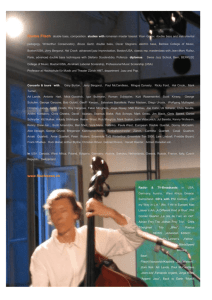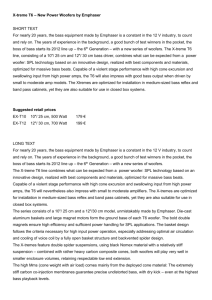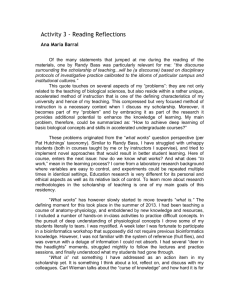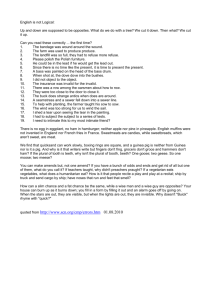SWIM FOR YOUR LIFE!
advertisement
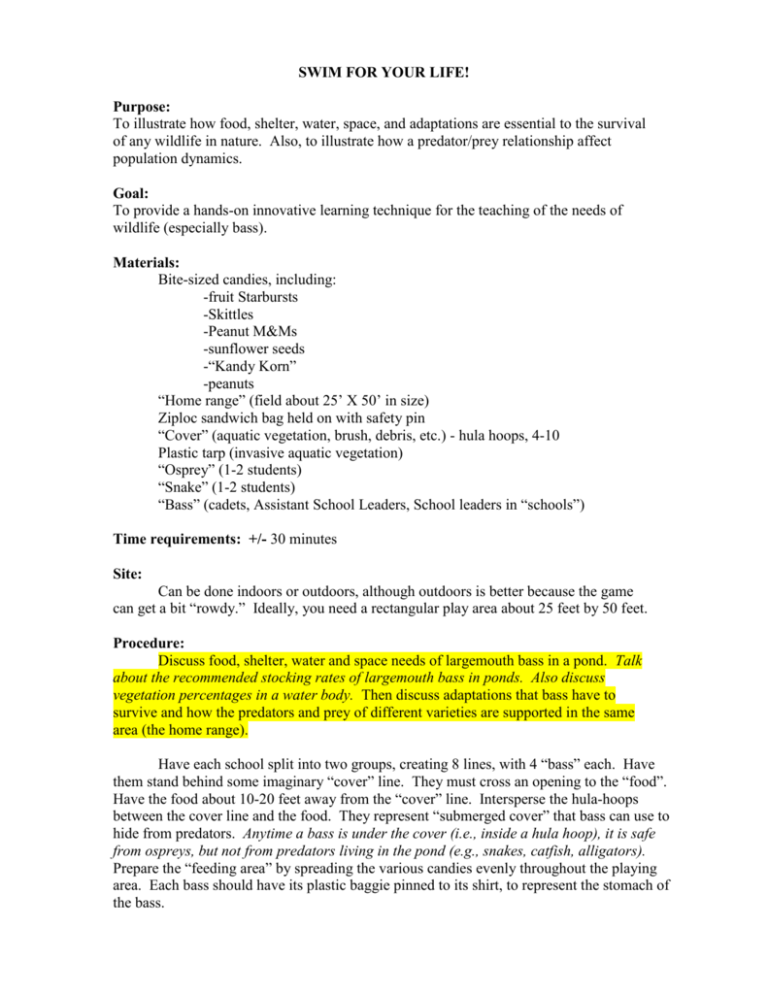
SWIM FOR YOUR LIFE! Purpose: To illustrate how food, shelter, water, space, and adaptations are essential to the survival of any wildlife in nature. Also, to illustrate how a predator/prey relationship affect population dynamics. Goal: To provide a hands-on innovative learning technique for the teaching of the needs of wildlife (especially bass). Materials: Bite-sized candies, including: -fruit Starbursts -Skittles -Peanut M&Ms -sunflower seeds -“Kandy Korn” -peanuts “Home range” (field about 25’ X 50’ in size) Ziploc sandwich bag held on with safety pin “Cover” (aquatic vegetation, brush, debris, etc.) - hula hoops, 4-10 Plastic tarp (invasive aquatic vegetation) “Osprey” (1-2 students) “Snake” (1-2 students) “Bass” (cadets, Assistant School Leaders, School leaders in “schools”) Time requirements: +/- 30 minutes Site: Can be done indoors or outdoors, although outdoors is better because the game can get a bit “rowdy.” Ideally, you need a rectangular play area about 25 feet by 50 feet. Procedure: Discuss food, shelter, water and space needs of largemouth bass in a pond. Talk about the recommended stocking rates of largemouth bass in ponds. Also discuss vegetation percentages in a water body. Then discuss adaptations that bass have to survive and how the predators and prey of different varieties are supported in the same area (the home range). Have each school split into two groups, creating 8 lines, with 4 “bass” each. Have them stand behind some imaginary “cover” line. They must cross an opening to the “food”. Have the food about 10-20 feet away from the “cover” line. Intersperse the hula-hoops between the cover line and the food. They represent “submerged cover” that bass can use to hide from predators. Anytime a bass is under the cover (i.e., inside a hula hoop), it is safe from ospreys, but not from predators living in the pond (e.g., snakes, catfish, alligators). Prepare the “feeding area” by spreading the various candies evenly throughout the playing area. Each bass should have its plastic baggie pinned to its shirt, to represent the stomach of the bass. Set I (1-3 rounds) Allow the bass to “feed” for several rounds (2-3) without any predators present. They may “swim” up very leisurely, one bass at a time, from each school, and select their “forage” from the pond. As they select their forage, it should be placed inside the Ziploc bag to be “digested”. They can select only one food item at a time and then return behind the cover line to wait their next turn at feeding. Set II (1-2 rounds) Then, instruct the bass that in nature it is not that easy to feed because of predators. Introduce one osprey. The participant portraying the osprey, being an agile flyer capable of diving and catching bass, can run. Bass are safe when in cover (within the hula hoop). Bass will share their cover with other bass, therefore no more than two (2) bass can share cover at the same time. If two (2) bass are already in cover, another bass cannot join or replace a bass. If a bass is caught (gently tagged) by the osprey, they must leave the area and sit to the side for the remainder of the game. Set III (1-2 rounds) After the first couple of rounds explain to the “bass” that the landowner is absent and not managing his pond. Because of this, aquatic vegetation has started to take over the pond. Use cadets that are no longer playing to “invade” the pond with the tarp. Before starting the first round, ask the “bass” how the vegetation will affect them, both positively and negatively. The tarp will slowly enter into and move across the pond over several rounds. As the tarp moves across the pond it will also be lowered to represent the loss of oxygen in the water due to the growth of the vegetation, which prevents sunlight for other submerged plant and algae growth. Bass will be able to swim under the tarp and be safe from the osprey, but not from the snake (introduced in the next set). As the tarp is lowered (representing the decrease in oxygen), bass will find it more difficult to maneuver underneath the tarp. Set IV (1-2 rounds) Introduce one snake. The participant portraying the snake, being an aquatic predator capable of invading cover, can eat bass throughout the area, both outside of and inside cover, however, can only move at a walking pace. If a bass is caught (gently tagged) by the snake, they must leave the area and sit to the side for the remainder of the game. Wrap-Up How many bass are left? Review the major components: cover, food, predators, pros/cons of aquatic vegetation Were any food items selected for over others? Chances are the “starbursts” received heavier use. Tell the bass that these are sunfish, the most needed and preferred food item.


